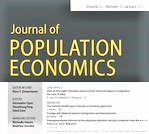A new paper published in the Journal of Population Economics finds for the USA that ethnic attrition biases conventional estimates of health disparities between Mexican Americans and non-Hispanic whites as well as those between Mexican Americans and recent Mexican immigrants.
Read more in:
Ethnic attrition, assimilation, and the measured health outcomes of Mexican Americans
Francisca M. Antman, Brian Duncan & Stephen J. Trejo
Journal of Population Economics (2020) 33, Issue 4: 1499-1522
FREE READLINK
GLO Fellow Francisca M. Antman
Author Abstract: The literature on immigrant assimilation and intergenerational progress has sometimes reached surprising conclusions, such as the puzzle of immigrant advantage which finds that Hispanic immigrants sometimes have better health than US-born Hispanics. While numerous studies have attempted to explain these patterns, almost all studies rely on subjective measures of ethnic self-identification to identify immigrants’ descendants. This can lead to bias due to “ethnic attrition,” which occurs whenever a US-born descendant of a Hispanic immigrant fails to self-identify as Hispanic. In this paper, we exploit information on parents’ and grandparents’ place of birth to show that Mexican ethnic attrition, operating through intermarriage, is sizable and positively selected on health, making subsequent generations of Mexican immigrants appear less healthy than they actually are. Consequently, conventional estimates of health disparities between Mexican Americans and non-Hispanic whites as well as those between Mexican Americans and recent Mexican immigrants have been significantly overstated.
GLO Discussion Paper No. 470, 2020
Access to the newly published complete Volume 33, Issue 4, October 2020.
LEAD ARTICLE OF ISSUE 4:
Yun Qiu, Xi Chen & Wei Shi, Impacts of social and economic factors on the transmission of coronavirus disease 2019 (COVID-19) in China
Journal of Population Economics 33, 1127–1172 (2020). OPEN ACCESS

Ends;
